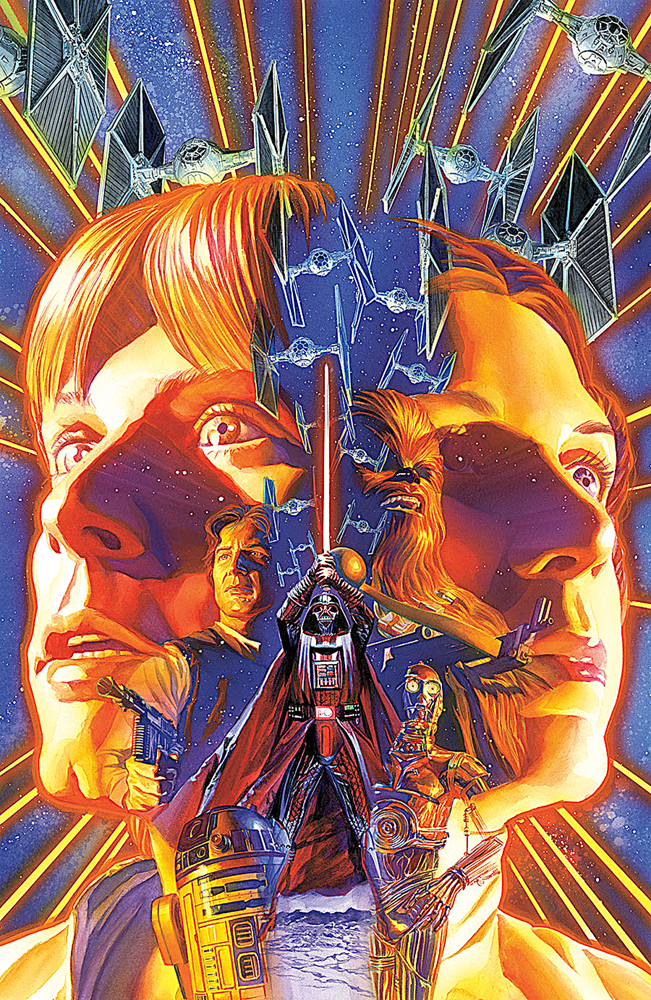Star Wars might have the biggest expanded universe of any franchise. With so many books and video games, it’s tough to know where to start if you’ve just watched the movies. Dark Horse Comics is pushing its new comic series, simply titled Star Wars, as the place to start. The first collection has just been released in a hardcover collection.
Written by Brian Wood and drawn by Carlos D’anda, the book takes place right after the original movie following the destruction of the first Death Star. This makes it easy for pretty much anyone of reading age to pick up the comic and know what’s going on, as Star Wars is one of the few givens when it comes to common movie knowledge.
Wood has a real challenge in making this story exciting. Because we already know what happens to the characters we care about, there are no stakes when it comes to dangerous situations. In one scene, Han Solo admits “I’m not dying here!” during a fight scene with some Stormtroopers, and we all know it’s true—he still needs to live to be frozen in carbonite in The Empire Strikes Back and later rescued by Luke and Leia in Return of the Jedi.
Instead of inventing some massive world-ending conflict that secretly happened between two movies, Wood builds upon implications from the first movie that weren’t explored in subsequent films. Part of the story revolves around Darth Vader and his quest for redemption. His boss, the Emperor, is understandably a little miffed that his moon-sized space station was blown up on Vader’s watch. Stripped of his ship in favor of a young, lantern-jawed upstart, Vader has to find a way to get out of the galactic imperial doghouse he has found himself in. And he’s not playing around; those who cross him find that Vader doesn’t have time for the traditional Force-choking runaround, instead favoring a more classic method of punishment.
On the light side of the Force, Leia is tasked with heading up a kind of starfighter black ops team, one that may or may not have a spy among its ranks. Between secret missions, spy-hunting and struggling with her feelings of Luke, Leia has no choice but to bury her grief for her home world, Alderaan, and the billions of citizens that were annihilated by the Death Star.
Aside from a slow start, the book is well-paced and full of fun moments (usually involving Han and Chewbacca) in between the self-serious space opera plotting. The ending wraps up a few story threads while leaving many more dangling, more like the episode of a TV show than a cohesive stand-alone film. More volumes are on their way, promising to explore finer points introduced in the initial arc, like Vader’s new middle-aged female protege.
Star Wars comes with high expectations from fans, especially dealing with its most established characters. Wood does an admirable job of capturing the essence of the major players—there are no lines that seem off-key, no actions that seem out of place.
Though no character is given inner monologue, sometimes an omniscient narrator chimes in with a tone that echoes the famous opening scrawl at the start of each film. It can be helpful at times, explaining details and recapping particular histories, but in some cases it can be a nuisance.
In one scene, the yellow narration boxes simply explains what is happening during a space battle, culminating in a single box reading “And then…” followed by an explosion. Narration isn’t necessary here—the visuals should be enough to carry the action, and the yellow boxes only slow down what should be an exciting scene.
Artist Carlos D’anda is more than capable of handling a space dogfight on his own. The various ships and star cruisers are probably the best-looking in the book, meticulously detailed down to the circuit-like surface of a Star Destroyer.
In the cockpit, we see that Luke and Leia aren’t perfect replicas of their on-screen counterparts. Whether artistic choice or contractual obligation, the characters from the movies look less like actors and more like, well, buff and buxom comic book heroes. It works because it’s consistent with the rest of the world within the comic, but sometimes it’s easy to confuse the generic strong chin of Han Solo with that of bit player Wedge Antilles.
Filling in the lines is colorist Gabe Eltaeb, who knows how to light blaster fire just as well as he knows the tint of a space helmet visor. Maybe most impressive is his Vader, whose iconic solid-black garb can’t be easy to color in a provocative way, as Eltaeb does.
Dark Horse has scores of great Star Wars comics to choose from, but it remains to be seen if Disney’s acquisition of the franchise (thus bringing it under the same house as
Marvel Comics) will affect its legacy going forward. For now, Wood, D’anda and Eltaeb’s Star Wars is good place to get started with a lot of potential.





